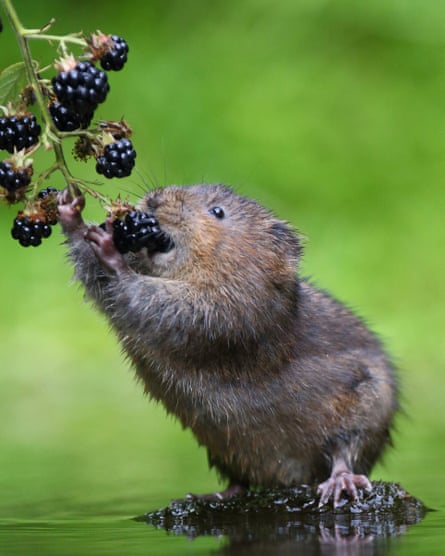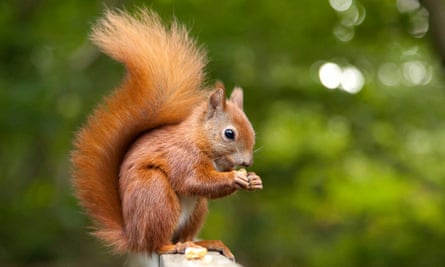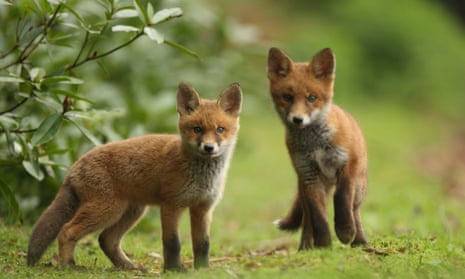Britons have been asked to name their favourite mammal. A Royal Society of Biology (RSB) poll, launched on Sunday, will seek to pinpoint which non-domestic creature – found within our shores and coastal waters – is closest to the nation’s heart. Candidates include the water vole, highland wildcat, fox, bottlenose dolphin, red squirrel and soprano pipistrelle bat.
The poll, set up as part of Biology Week, which began on Saturday, is aimed at finding out what British people value most in the environment. “People act on what they care about, so it’s not just fun to explore their preferences and preconceptions, it’s useful too,” said Professor David Macdonald, director of Oxford University’s Wildlife Conservation Research Unit. “We already know that the global favourites are big cats, and that knowledge can mobilise conservation campaigns – so let’s find out which UK mammal people most want to champion.”
Last year a similar competition organised by the RSB saw the buff-tailed bumblebee being named the nation’s favourite insect.

Britain is home to 101 species of mammal. Some are recent arrivals, others have had their homes here since the last ice age. All are eligible for consideration in the poll. “The grey squirrel arrived about 150 years ago and the American mink appeared in the 1920s,” said Macdonald. “By contrast, rabbits go back to Roman times and the fallow deer to pre-Norman times. As far as I am concerned, if it has fur and four legs and you see it in a local field, then it’s a British mammal.”
Most animals on the list are land animals with only a few exceptions. The tiny soprano pipistrelle (Pipistrellus pygmaeus) – one of 18 species of bat found in the UK – is widespread and can consume more than 3,000 insects in a night. In addition, the bottlenose dolphin (Tursiops truncatus) is found in several different parts of the country, including the sea off Wales and Scotland. Many of Britain’s mammals are now endangered as natural habitats disappear and farming intensifies. The water vole, often confused with brown rats (Ratty of The Wind in the Willows was actually a water vole), is now one of the nation’s fastest disappearing mammals.
Once found in almost every waterway in England, Wales and Scotland, Arvicola amphibius has disappeared from 90% of its former sites. The hedgehog (Erinaceus europaeus) has suffered from a drastic decline for the same reason: loss of habitat. The hedgehog population is estimated to number less than 1 million, down from more than 30 million in the 1950s. One third of this loss is thought to have taken place in the past 10 years.
By contrast, the highland wildcat has suffered catastrophic decline for a very different reason. Felis silvestris can breed with the domestic cat and is losing its genetic integrity as a result. Surveys suggest pure-bred wildcat numbers are now lower than 400.
“Whichever mammal you choose, it’ll be bumping up against some inconvenient aspect of the 21st century and will need society’s support to prosper,” Macdonald said. “For a nation that widely encourages others to protect wildlife in their communities, let us practise what we preach by nurturing the wildlife in our own backyards.”

Not every favourite candidate on the mammal poll list is doing badly. After the ban on otter hunting in 1978, along with a general improvement in water quality in rivers, numbers of otters (Lutra lutra) have slowly risen. The beaver (Castor fiber) has rebounded after becoming extinct, due to intense hunting, in the 16th century. Small numbers were reintroduced and the beaver is now a re-established UK resident – and a poll candidate.
Finally there is the red fox (Vulpes vulpes) which has also thrived in recent years, spreading into urban areas and settling in large numbers. The animal is considered a pest in many areas, both in the country and the city. Nevertheless it is Macdonald’s personal favourite to win the favourite mammal accolade for Britain. “They are beautiful, adaptable opportunists. Yes, they can be pests, but when you see one and catch the amber sparkle of their eyes, I defy anyone to find any animal in this country that is more lovely.”











Comments (…)
Sign in or create your Guardian account to join the discussion